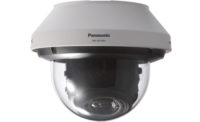In discussing the state of 4K resolution in the security industry for an article in the March 2015 issue of SDM, several industry insiders concurred that while 4K — also known as ultra HD or UHD — is definitely the future of video surveillance, it wasn’t quite ready for greater adoption at that time. Given the rapid pace with which technology advances in the industry, it is somewhat surprising that that assessment hasn’t changed very much in the last nine months.
However, as we approach a new year, there are signs that the anticipated “age of 4K” is getting closer to fruition due in large part to advances in some of the technological developments that have held back deployment of 4K cameras. With 4K TVs and Blu-Ray players expected to be among the top sellers this holiday season, the “mainstreaming” of 4K in the consumer market also helps.
“Everyone is getting better educated about the value of higher resolution images, especially when you consider that the cameras in almost all smartphones take still images at more than 4K. We are even seeing smartphones that shoot 4K video,” says Mark Espenschied, director of marketing, Digital Watchdog, Cerritos, Calif. “The prices of 4K TVs are coming down, influencing those who were early to the 1080p HD TV market to stay ahead of their friends by owning the latest technology; 4K is definitely getting more and more into the conversation from early adopters to the last-to-buy.”
What this means for security remains to be seen, but for now there is growing optimism that 4K will come into its own in the not-so-distant future.
If & When
One of the most significant contributions 4K is making in security is the ability to deliver on end users’ formerly unrealistic expectations.
“High resolution combined with today’s analytics makes yesterday’s science fiction a reality today,” Espenschied says. “All the forensic zooming Hollywood has shown us was actually impossible; massive resolution makes it a reality.”
However, for all the talk about 4K and its benefits, the market for the technology remains rather limited for a number of reasons.
“While integrators and end users are asking about 4K, and some specs are starting to ask for it, there’s very little understanding today of the state of 4K technology or the impact 4K will have,” says Jason Spielfogel, director of product management, Pelco by Schneider Electric, Clovis, Calif. “I think companies that have 4K right now don’t do enough to talk about the limitations of the technology today because that conversation doesn’t contribute to their bottom line.”
In 2014, the industry was simply not ready for 4K, with just a few early adopters buying UHD cameras to try, says Cheryl Bard, regional marketing manager, Bosch Security, Fairport, N.Y. That has shifted somewhat in recent months. “In 2015, market demand has increased. More end users and integrators are specifying and using 4K cameras in their security systems, including many different types of camera styles: bullet, panoramic, dome, and fixed body,” she describes.
Nearly every new security technology goes through a period where its price tag is cost-prohibitive for the majority of users. This is a given, and 4K is no exception.
“Recognizing where 4K technology best fits into surveillance system models is really a question of need versus cost at this point in time. However, we continue to see that for specific applications, the need for 4K justifies the extra cost,” says Brad Donaldson, director of product management, Arecont Vision, Los Angeles. “As the demand for 4K cameras continues to grow and drive higher production quantities, we should also expect that the prices of 4K cameras will eventually decrease as they get even better.”
As with anything new, the price of 4K cameras is expected to come down as the technology matures and adoption increases. However, camera costs are only part of the equation with 4K.
“While the benefits of higher and higher resolution video are apparent in surveillance, the bandwidth demands on the IP network tend to be an obstacle for integrators since the cost of the camera goes up and often times the cost of the infrastructure to support it goes up as well,” Espenschied relates. “For now, 4K is a commitment where, depending upon the application, the increased expense could easily be worth the risk if it produces the evidence needed to prosecute or to avoid an injury lawsuit/settlement.”
The solution to this dilemma would seem to be the new H.265 compression algorithm. While H.264 can certainly help reduce bandwidth and storage requirements, H.265 has been developed specifically for 4K, making it a much better tool for reducing infrastructure requirements and costs. However, like 4K itself, H.265 is not a widely available or widely adopted standard, yet.
“H.265 compression, when widely available, may be the piece needed to further reduce bandwidth requirements and increase adoption,” Bard says.
While there are still limitations, the good news is that camera manufacturers recognize these factors and continue to work to address them, as evidenced by a number of improvements over the last two years. “The technology has come a long way since its introduction in 2013,” says Ahmed Elsayed, national accounts application engineer, Hikvision USA, City of Industry, Calif. “Larger sensors, higher-quality lenses and improvements in IR technology have helped overcome the age-old weakness of higher resolution’s poor low-light performance.”
Common Misconceptions
While the industry waits to see if there is a wider market for 4K, what that market might be and when greater adoption may occur, there’s the very real possibility that that might take quite some time. It’s also possible that 4K may not gain the level of adoption that manufacturers might prefer.
“I think the biggest misconception is that merely throwing more pixels at your surveillance challenges will overcome them. We saw this a few years back when 1080p came out,” Spielfogel says. “Another misconception is that everyone needs higher resolution. Keep in mind, if you have a small field of view, such as a hallway or small conference room, 720p is probably all you need, maybe not even that much resolution.”
Another thing people might not realize is that a 4K monitor is not essential for viewing 4K video. “In actuality, a 1080p monitor is just fine, especially since viewing details during retrospective analysis is one of the more important benefits of using a 4K camera,” Bard says.
Elsayed says the affordability of 4K technology is another misconception, specifically that the costs may not be as steep as you might think. “With technological advances in compression and increased availability in supporting technologies, high-quality 4K cameras are now within the price range of the average consumer,” Elsayed says. “Another misconception is that 4K bandwidth requirements exceed the abilities of existing networks. In fact, when properly configured, it can utilize standard existing Ethernet mediums.
“The most important factor for integrators when working with 4K technologies is the critical role that high-quality infrastructure components will play,” he adds. “When designing these systems, one must ensure the use of high-quality cabling, network devices, and end-user viewing platforms.”
For more on the misconceptions, see related article, “Debunking the Myths Around 4K,” on page 104.
Applications & Opportunities
Yes, there are still a number of limiting factors that have inhibited the adoption of 4K, but that doesn’t mean there are no opportunities for integrators to work with the technology. However, it’s important to know just where to look for those opportunities.
“The best use for 4K is to monitor large areas without sacrificing pixels on target and providing the ability to maintain a quality image when zooming in digitally. This makes these cameras ideal for large campuses, city surveillance, and the government sector, to name a few,” Elsayed describes.
The main reason 4K is ideal in these types of deployments can be summed up in a single word: Zoom. “4K cameras offer real value for security practitioners who need to monitor and record large areas. Their higher resolution enables the use of wider field of views while maintaining the appropriate pixels on target to meet operational requirements,” says James Marcella, director of technical services and security industry liaison, Axis Communications, Chelmsford, Mass.
Early adopters of 4K technology have been those users who can most benefit from the combination of the highest resolution and frame rates possible.
“The casino gaming vertical market is one example of a market that has opted for early adoption for high-stakes gaming and areas where large amounts of cash are exchanged,” Donaldson explains. “Other early deployments of 4K cameras may eventually make their way into stadiums, airports, distribution centers, shopping malls, and government facilities.”
For integrators, when it comes to deciding whether or not to recommend 4K to customers, both the hype around 4K and its unsettled role in the security industry have to be irrelevant.
“The best thing integrators can do is make educated recommendations for their customers, whether it be for 4K or against it,” Marcella says. “We all know that 4K is more expensive, but integrators should be making recommendations based on customers’ operational requirements.”







